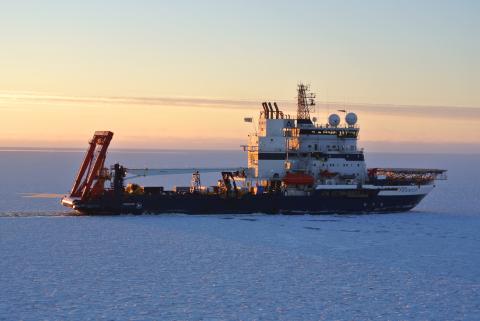Earlier in September the U.N. Environment Program and World Meteorological Organization released their latest report that indicated the Earth’s protective ozone layer is recovering due to the regulation of ozone-damaging gases. This report is the first comprehensive report in four years and comes to many as reassuring that we can put in place global regulations and processes that can curb human caused negative atmospheric effects.
The report is certainly not grounds to think we have won the ozone depletion war. Harmful emissions of all sorts not only continue but rapid increases in some ozone depleting substances and other deleterious emissions could easily set back the advances in ozone reduction that have been achieved. Here in the Arctic, their presence is seen and measured by research ships such as Mirai.
Onboard Mirai during this cruise, Japanese researchers have been conducting specific ozone measuring observations by radiosonde for the first time from this ship in the Arctic, filling what otherwise is a huge gap in Arctic ozone data. To date Arctic ozone measurements have been made almost totally by satellite. The new radiosonde data is more accurate as the radiosonde’s onboard sensors measure directly ozone quantity as the balloons life the instrument package through the atmosphere. Initial data here is that the satellite data is reasonably accurate, though it appears that it indicates lower ozone quantities than actually exist. I should note that trend data has not yet been analyzed, only daily comparison of Mirai’s actual measurements and the those calculated by the satellite sensors.
Mirai’s sensor array is impressive. Continuous sampling of many different substances is ongoing. Some researchers have been measuring a number of Persistent Organic Compounds (POPs) and the residuals of toxic Perfluoralkyl Substances (PFAC’s – the toxic components of now banned surfactants like Scotchgard). Still many years after the bans on many specific PFAC’s were instituted, residuals are still making their way into the Arctic food chain.
One of the other airborne emissions that is causing concern of late is black carbon. In our marine industry, black carbon is one component in stack gas emissions from many ships. Onboard RV Mirai the hghly sensitive instruments to record black carbon are mounted well forward in the foremast, and samples are only taken when the relative wind is ahead of the beam, so as not to be affected by possible contamination by Mirai’s own exhaust gases. Interestingly, a very identifiable spike in black carbon count was recorded during the passage of a ship southward along the Alaskan coast during the intensive observation period at Weather Station Mirai.
In an environment as sensitive as the Arctic, many believe that black carbon emissions should be banned, or at the very least curbed dramatically. Technology certainly exists to reduce if not totally eliminate black carbon emissions from ship’s exhaust. Arctia Shipping Offshore recently retrofitted their icebreakers Fennica and Nordica to comply with US regulations with respect to shipboard exhaust and has seen extremely positive results with relatively little financial cost.
Ship’s exhaust emission regulations are not uniform around the globe unfortunately. In an attempt to remedy the inconsistency in exhaust gas emission requirements and to possibly provide additional protection for the sensitive Arctic environment, the IMO’s Marine Environmental Protection Committee (MEPC) will be discussing various environmentally concerned provisions for inclusion in the Polar Code next week in Working Group and the week after in Committee. These promise to be interesting discussions, as many in the marine industry do not feel anything close to a complete ban on black carbon emissions from ships operating in the Polar Regions is necessary or economical. There are certainly a number of passionate researchers onboard this ship that feel differently.
3 Oct 2014

